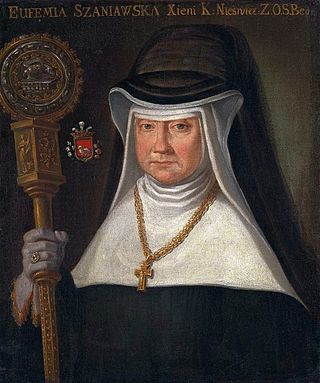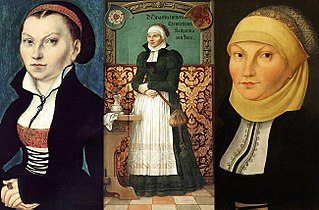Related Research Articles

An abbess, also known as a mother superior, is the female superior of a community of Catholic nuns in an abbey.

A nun is a woman who vows to dedicate her life to religious service and contemplation, typically living under vows of poverty, chastity, and obedience in the enclosure of a monastery or convent. The term is often used interchangeably with religious sisters who do take simple vows but live an active vocation of prayer and charitable work.

A convent is a community of monks, nuns, friars or religious sisters. Alternatively, convent means the building used by the community. The word is particularly used in the Catholic Church, Lutheran churches, and the Anglican Communion.

The Bridgettines, or Birgittines, formally known as the Order of the Most Holy Savior, is a monastic religious order of the Catholic Church founded by Saint Birgitta in 1344 and approved by Pope Urban V in 1370. They follow the Rule of Saint Augustine. There are today several different branches of Bridgettines.


A double monastery is a monastery combining separate communities of monks and of nuns, joined in one institution to share one church and other facilities. The practice is believed to have started in the East at the dawn of monasticism. It is considered more common in the monasticism of Eastern Christianity, where it is traceable to the 4th century. In the West the establishment of double monasteries became popular after Columbanus and sprang up in Gaul and in Anglo-Saxon England. Double monasteries were forbidden by the Second Council of Nicaea in 787, though it took many years for the decree to be enforced. Double monasteries were revived again after the 12th century in a significantly different way when a number of religious houses were established on this pattern among Benedictines and possibly the Dominicans. The 14th-century Bridgittines were purposely founded using this form of community.

The status of Women in the Protestant Reformation was deeply influenced by Bible study, as the Reformation promoted literacy and Bible study in order to study God's will in what a society should look like. This influenced women's lives in both positive and negative ways, depending on what scripture and passages of the Bible were studied and promoted. The ideal of Bible study for commoners improved women's literacy and education, and many women became known for their interest and involvement in public debate during the Reformation. In parallel, however, their voices were often suppressed because of the edict of the Bible that women were to be silent. The abolition of the female convents resulted in the role of wife and mother becoming the only remaining ideal for a woman.

The Abbey Pax Mariae, more commonly referred to as Vadstena Abbey, situated on Lake Vättern in the Diocese of Linköping, Sweden, is a monastery of nuns within the Bridgettine Order. It was active from 1346 until 1595 and has been active since 1963, regaining statues as an autonomous abbey in 1991.

Stanbrook Abbey is a Catholic contemplative Benedictine convent with the status of an abbey, located at Wass, North Yorkshire, England.

Erentrude was a saint and abbess, born during the end of the 7th century, probably in present-day Germany or Austria. She was born into a Franconian-Merovingian royal house, and was the niece of Rupert of Salzburg. She left her home country to assist Rupert in establishing religious communities in Salzburg; in about 700, he built a convent, Nonnberg Abbey, and installed her as its first abbess. She and the nuns at Nonnberg served the poor, needy, and ill, striking a balance between living as cloistered nuns and engaging in charitable works. Erentrude died on 30 June 718. Her fame for healing miracles and intercession grew after her death, and many legends have arisen throughout the centuries since her death. In 2006, Erentrude's image appeared on the Austrian Nonnberg Abbey commemorative coin. Her feast day is celebrated on 30 June.

Countess Charlotte Flandrina of Nassau was a french abbess. She was the fourth daughter of William the Silent and his third spouse Charlotte of Bourbon.

The Abbaye Blanche was a nunnery founded in 1112 in Mortain, France.
St. Cecilia's Abbey, Solesmes is a Benedictine convent, founded in 1866 by Dom Prosper Guéranger, the restorer of Benedictine life in France after the destruction of the revolution. It is located in Solesmes, Sarthe, and is the women's counterpart of Solesmes Abbey.

Dame Mary Joseph Butler was the first Irish Abbess of the Irish Benedictine Abbey of Our Lady of Grace, at Ypres, Flanders.

St. Clare's Priory, Stockholm, was a Roman Catholic nunnery of the Poor Clares in Stockholm, Sweden that was active from 1289 to the Swedish Reformation in 1527.
Birgitta Botolfsdotter, or Botulfsdotter was a Swedish Roman Catholic nun, abbess of Vadstena Abbey during the ongoing Protestant Reformation.
Kirkjubæjar Abbey, in operation from 1186 until the Icelandic Reformation, was a monastery in Iceland of nuns of the Order of St. Benedict. It was located at Kirkjubæjarklaustur. Iceland had nine religious communities before the Reformation, two of which were monasteries of nuns, of which this is the first and oldest.
Ter Hage Abbey, was a Roman Catholic convent for females of the Cistercian Order in Axel, Netherlands, in operation from 1269 until 1572.
Josina Walburgis van Löwenstein-Wertheim-Rochefort (1615-1683) was sovereign Princess Abbess of Thorn Abbey from 1631 until 1632.
Elizabeth Knatchbull religious name Lucy was the founding English abbess of the Convent of the Immaculate Conception in Ghent.
References
- Kees Kuiken, Vos, Amalberga, in: Digitaal Vrouwenlexicon van Nederland. URL: http://resources.huygens.knaw.nl/vrouwenlexicon/lemmata/data/VosAmalberga [13/01/2014]